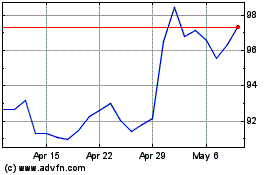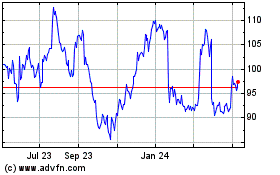By Daniel Kruger and Akane Otani
The yield on the 10-year U.S. Treasury note hit 3% for the first
time since 2014 in a vote of confidence for the economic expansion,
but warnings from large companies that profits were peaking helped
send the Dow industrials to their fifth straight decline.
Investors on Tuesday dealt with two conflicting messages. The
rise in bond yields early in the day was a signal that the Federal
Reserve might have to raise interest rates more rapidly to respond
to economic growth and the prospect of more inflation. That could
add fuel to the long stock rally.
Yet a handful of large companies sounded a different tune: It
might not get much better than it is now.
That sent both stocks and bonds down, the latest move in a wave
of volatility after a banner year in which nearly all assets seemed
to be constantly charging higher. The Dow Jones Industrial Average
tumbled 424.56 to 24024.13, leaving it 9.7% below its Jan. 26
record close.
Shares of heavy-machinery manufacturer Caterpillar Inc. --
considered a bellwether for industrial America -- tumbled 6.2%
after company officials cautioned first-quarter results could mark
a "high-water mark for the year," while multinational conglomerate
3M Co. shed 6.8% after the company trimmed the top end of its
fiscal-year earnings guidance.
"If you've got production costs going up and interest costs
going up, you're saying, wait a minute -- is this as good as it's
going to get?" said Michael Farr, president of Farr, Miller &
Washington, a money-management firm.
Bond yields had slumped near historic lows in the postcrisis
years as economic growth contracted and the Federal Reserve
undertook bond buying on a massive scale. A rise to 3% signifies in
part that the economy is returning to near normal conditions in
which a rapid deceleration is deemed less likely than it was in the
years immediately after the crisis.
Yet many analysts believe the U.S. is in the late stages of the
economic cycle, and say a rapid run-up in bond yields could pose a
threat to the stock rally, with rising inflation rates discouraging
consumer spending and increasing labor costs.
The yield on the benchmark 10-year U.S. Treasury note, a
barometer that influences borrowing costs for consumers,
corporations and state and local governments, rose as high as
3.001% Tuesday -- its highest intraday level since Jan. 9, 2014 --
before settling at 2.983%, up from 2.973% Monday. Yields rise as
bond prices fall.
The 10-year yield's half-percentage point climb to similar
heights earlier this year contributed to the tumble that sent
stocks into correction territory in February, as higher yields
dented investors' confidence that stock valuations could rise
unceasingly.
Stocks had appeared to stabilize in the months following the
selloff, with the S&P 500 reclaiming positive territory for the
year after a 10% fall from its Jan. 26 high. Yet the stock market's
lackluster response to earnings reports Monday and Tuesday,
combined with the fresh rise in bond yields, has renewed investor
fears of a resurgence in selling.
"The repricing of interest rates is potentially a bigger
headwind for financial markets than the real economy," said Ashok
Bhatia, a senior portfolio manager in Neuberger Berman's Fixed
Income Multi-Sector Group.
Not all are convinced that bond yields will continue their march
higher. The 10-year yield has topped 3% several times since the
financial crisis, only to soon retreat below the level. That
pattern has left investors debating whether this latest surge marks
a new phase in the recovery or the latest in a series of false
starts.
"We are a buyer of 10-year Treasurys" versus riskier assets,
said James Camp, managing director for fixed-income at Eagle Asset
Management. He said investors who prize dividend income may begin
to find bonds at higher yields more attractive.
Still, many believe long-nascent inflation could finally be
picking up, something that they expect will ultimately nudge bond
yields higher.
U.S. crude is approaching $70 a barrel for the first time since
2014, while tighter trade policies, including tariffs on steel and
aluminum imports, are threatening to drive prices across the
economy higher. Inflation poses a threat to the value of government
bonds because it chips away at the purchasing power of their fixed
payments and can push the Fed to raise interest rates.
Further increases in interest rates could pressure stocks, which
for years had benefited from anemic bond yields that made their
returns look relatively attractive.
"For a long time, stocks were essentially the only game in
town," said Jack Ablin, chief investment officer at Cresset Wealth
Advisors. "As interest rates become more competitive, that's going
to put more pressure on equities."
Others see a warning sign in the narrowing distance between
short- and longer-term bond yields, known as a flattening yield
curve. Two-year yields -- which fell to 2.466% on Tuesday -- tend
to rise along with investors' expectations for tighter Fed policy,
while longer-term yields are more responsive to the outlook for
growth and inflation.
Because short-term rates have exceeded longer-term rates before
each recession since at least 1975 -- a phenomenon known as an
inverted yield curve -- investors become wary as the curve
flattens.
The pace of flattening suggests the yield curve could invert in
early 2019, with a recession following a little more than a year
after, said Adrian Helfert, deputy head of global aggregate
investing at Amundi Pioneer.
Yet the flattening has occurred while economic growth continues
to be steady, and few analysts see signs of any imminent
slowdown.
While investors debate the meaning of the flattening curve, one
factor that could propel yields higher is increased government
borrowing. This year's rise in yields came after the passage of
$1.5 trillion in tax cuts and the bigger bond sales the government
needs to finance them. The Congressional Budget Office forecasts
that the deficit will top $1 trillion in 2020 and remain above that
level for the foreseeable future.
Yet other factors could cap the climb in bond yields. Because
the 10-year yield is a benchmark rate used to help set interest
rates for different kinds of loans, including mortgages, auto loans
and corporate debt, higher yields increase the cost of debt, which
can act as a brake on the economy. Yields remain low by historical
standards and the implied inflation forecast from inflation-indexed
Treasurys recently hit a 2018 high of 2.19% for the next 10
years.
While the financial crisis happened almost 10 years ago, the
long path to 3% shows that the pain is only "slowly wearing off,"
said Jeremy Siegel, professor of finance at the University of
Pennsylvania's Wharton School.
Write to Daniel Kruger at Daniel.Kruger@wsj.com and Akane Otani
at akane.otani@wsj.com
(END) Dow Jones Newswires
April 24, 2018 20:11 ET (00:11 GMT)
Copyright (c) 2018 Dow Jones & Company, Inc.
3M (NYSE:MMM)
Historical Stock Chart
From Mar 2024 to Apr 2024

3M (NYSE:MMM)
Historical Stock Chart
From Apr 2023 to Apr 2024
